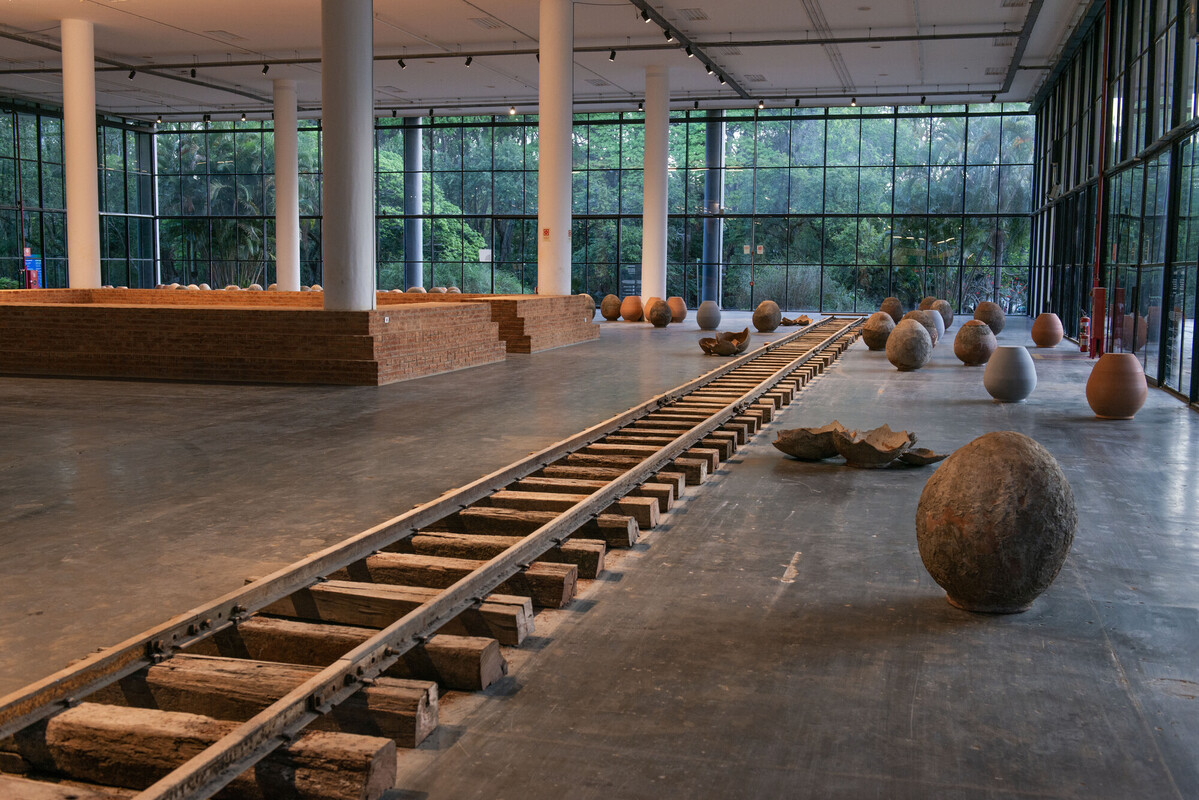
Ibrahim Mahama
The work of the alchemist has often been labeled “black work” referring to nigredo (“darkness” or “blackness” in Latin), the first step of the alchemical process, which means putrefaction or decomposition. Hence, the terms black work and blackness take on nihilistic implications. However, the alchemical processes of Ibrahim Mahama’s black work and blackness are about possibilism and the transmutation of coloniality.
Whether the colonial plantation, parliament hall, the railway, or other legacies of colonialism, the enclosures of coloniality are as systematic and interconnected. Mahama’s work sees possibilities in the material conditions of such enclosures and their abilities to tell stories and to connect moments in time along the extended arc from colonialism to globalization. These moments intersect with questions of labor, extraction, production, exploitation, and justice. The materials of his practice are the unextraordinary evidentiary objects that reveal systems of crisis or failure; yet, the artist’s transmutations yield poetic conditions of assemblage, assembly, and collectivity.
In his 2017 installation Non-Orientable Nkansa II, Mahama together with several collaborators produced hundreds of wooden “shoe-maker boxes” from scrap materials found in Kumasi and Accra, Ghana, and used for polishing and repairing shoes. These boxes contained the tools of “shoeshine boys,” often impoverished youth who daily navigate the city to polish or clean shoes for money. Mahama gathers together and stacks these hundreds of boxes into a monumentally scaled wall where each box seems precarious yet impossibly held in place.
Parliament of Ghosts (2019) is an assemblage of discarded and lost objects brought together to form the setting for a parliamentary hall and to recall the history of Ghana Railway company. The objects included in the work are found elements related to the history of production and the crisis of industrialization in colonial territories. The objects include abandoned train seats and railway sleepers, government documents, objects from a locomotive workshop, journals, maps, books, and archival furniture.
In his latest work, Mahama creates a space of assembly that is in dialogue with his previous Parliament of Ghosts, yet transmuted to become a location for collective black work, cultural production, and discourse during the 35th Bienal de São Paulo. The space reproduces the red brick bleachers in the hall of his RED CLAY studio in Tamale, Ghana. The installation also includes a set of vases from Ghana, and railroad tracks which reference the geography of the north of Ghana where the studio is located.
mario gooden
Ibrahim Mahama (Tamale, Ghana, 1987. Lives in Tamale) is best known for his sculptural installations that drape jute sacks over architectural structures like the National Theatre in Accra (Ghana), or the Arsenale at the 2015 Venice Biennale (Italy). He works with materials that tell a story of economy and global trade, crucial areas of inquiry for the artist. In recent years, Mahama has established three cultural institutions in Tamale, Ghana: the Savannah Centre for Contemporary Art (SCCA), Red Clay Studio, and Nkrumah Volini which looks into questions of transforming art from a state of commodity into a gift.
- Vista da instalação Parliament of Ghosts [Parlamento de fantasmas], de Ibrahim Mahama durante a 35ª Bienal de São Paulo – coreografias do impossível © Levi Fanan / Fundação Bienal de São Paulo
- Vista da instalação Parliament of Ghosts [Parlamento de fantasmas], de Ibrahim Mahama durante a 35ª Bienal de São Paulo – coreografias do impossível © Levi Fanan / Fundação Bienal de São Paulo
- Vista da instalação Parliament of Ghosts [Parlamento de fantasmas], de Ibrahim Mahama durante a 35ª Bienal de São Paulo – coreografias do impossível © Levi Fanan / Fundação Bienal de São Paulo
- Vista da instalação Parliament of Ghosts [Parlamento de fantasmas], de Ibrahim Mahama durante a 35ª Bienal de São Paulo – coreografias do impossível © Levi Fanan / Fundação Bienal de São Paulo
- Vista da instalação Parliament of Ghosts [Parlamento de fantasmas], de Ibrahim Mahama durante a 35ª Bienal de São Paulo – coreografias do impossível © Levi Fanan / Fundação Bienal de São Paulo
- Vista da instalação Parliament of Ghosts [Parlamento de fantasmas], de Ibrahim Mahama durante a 35ª Bienal de São Paulo – coreografias do impossível © Levi Fanan / Fundação Bienal de São Paulo
- Vista da instalação Parliament of Ghosts [Parlamento de fantasmas], de Ibrahim Mahama durante a 35ª Bienal de São Paulo – coreografias do impossível © Levi Fanan / Fundação Bienal de São Paulo
- Vista da instalação Parliament of Ghosts [Parlamento de fantasmas], de Ibrahim Mahama durante a 35ª Bienal de São Paulo – coreografias do impossível © Levi Fanan / Fundação Bienal de São Paulo

 Português
Português






